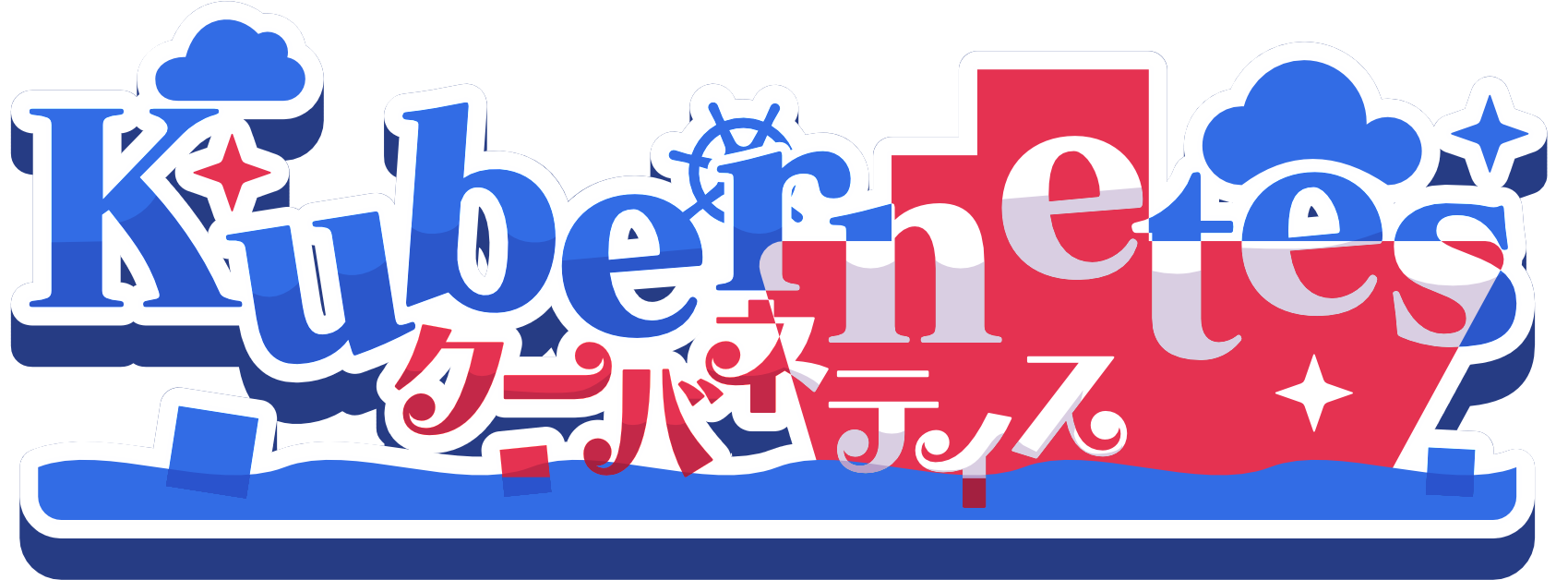K8s-etcd核心存储实现
K8s-etcd核心存储实现
基于1.25
什么是Etcd
etcd是K8s默认的数据持久化端存储,主要用于保存集群配置和状态
- etcd是分布式键值存储集群
- 基于Raft协议提供可靠强一致性数据存取服务
架构设计
REST Storage
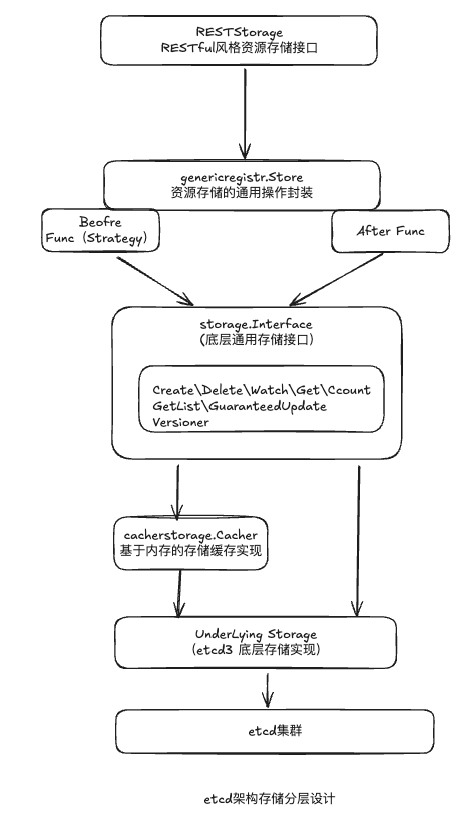
genericregistory.Store
genericregistory.Store封装了资源对象的CRUD操作,并且支持资源版本ResourceVersion的冲突检查
- 在存储资源对象前执行Beofre Func,存储资源对象后执行(After Func),以及处理DryRun
storage.Interface
底层通用存储接口,定义了资源的操作方法,Create|Delete|Watch|Get|Count|GETList|GuranteedUpdate|Versioner
cachestorage.Cacher
为了减轻etcd读取压力和提供了Cache,可以通过设置kube-apiserver的–watch-cache启动或者关闭Cacher,默认开启
Underlying Storage
后端存储,默认K8s使用etcd3,使用etcd client库实现storage.Interface
RESTStorage资源存储接口
K8s中,所有都通过Kube-apiserver RESTful API对外暴露资源,必须实现RESTSTorage才能对外注册到APIGroup
-
// Storage is a generic interface for RESTful storage services.
// Resources which are exported to the RESTful API of apiserver need to implement this interface. It is expected
// that objects may implement any of the below interfaces.
type Storage interface {
// New returns an empty object that can be used with Create and Update after request data has been put into it.
// This object must be a pointer type for use with Codec.DecodeInto([]byte, runtime.Object)
New() runtime.Object
// Destroy cleans up its resources on shutdown.
// Destroy has to be implemented in thread-safe way and be prepared
// for being called more than once.
Destroy()
}
可能还有获取到实时资源对象变化的能力:
-
// Watcher should be implemented by all Storage objects that
// want to offer the ability to watch for changes through the watch api.
type Watcher interface {
// 'label' selects on labels; 'field' selects on the object's fields. Not all fields
// are supported; an error should be returned if 'field' tries to select on a field that
// isn't supported. 'resourceVersion' allows for continuing/starting a watch at a
// particular version.
Watch(ctx context.Context, options *metainternalversion.ListOptions) (watch.Interface, error)
}
在K8s中,每种资源实现的RESTStorage,一般定义在pkg/registry/<资源组>/<资源>/storage/storage.go,通过NewREST或NewStorage实例化函数RESTStorage接口
-
// DeploymentStorage includes dummy storage for Deployments and for Scale subresource.
type DeploymentStorage struct {
Deployment *REST
Status *StatusREST
Scale *ScaleREST
Rollback *RollbackREST
}
// NewStorage returns new instance of DeploymentStorage.
func NewStorage(optsGetter generic.RESTOptionsGetter) (DeploymentStorage, error) {
deploymentRest, deploymentStatusRest, deploymentRollbackRest, err := NewREST(optsGetter)
if err != nil {
return DeploymentStorage{}, err
}
return DeploymentStorage{
Deployment: deploymentRest,
Status: deploymentStatusRest,
Scale: &ScaleREST{store: deploymentRest.Store},
Rollback: deploymentRollbackRest,
}, nil
}
// REST implements a RESTStorage for Deployments.
type REST struct {
*genericregistry.Store
}
genericregistry.Store通用操作封装
对一般的资源对象的通用操作进行了抽象和封装。形成了genericregistery.Store
- 有常规的资源存储需要
- 自动处理资源更新时的版本冲突检查
- 存储前后的钩子函数
- 支持服务端DryRun模式
标准存储实现
genericregistry.Store同时实现了StandardStorage和TableConvertor接口
StandardStorage:对基本的RESTStorage的拓展
TableConvertor:主要用于将资源对象列表转换为用户更好的表格形式
-
// StandardStorage is an interface covering the common verbs. Provided for testing whether a
// resource satisfies the normal storage methods. Use Storage when passing opaque storage objects.
type StandardStorage interface {
Getter
Lister
CreaterUpdater
GracefulDeleter
CollectionDeleter
Watcher
// Destroy cleans up its resources on shutdown.
// Destroy has to be implemented in thread-safe way and be prepared
// for being called more than once.
Destroy()
} -
type TableConvertor interface {
ConvertToTable(ctx context.Context, object runtime.Object, tableOptions runtime.Object) (*metav1.Table, error)
}
版本冲突检测
genericregistry.Store在执行资源更新的时候采用了乐观锁,通过对比更新前后资源的版本对象的Resource.Version是否变换判断本次更新是否冲突
多并发场景下,乐观锁能有效避免脏数据,K8s资源对象更新都会增大ResourceVersion
-
// Update performs an atomic update and set of the object. Returns the result of the update
// or an error. If the registry allows create-on-update, the create flow will be executed.
// A bool is returned along with the object and any errors, to indicate object creation.
func (e *Store) Update(ctx context.Context, name string, objInfo rest.UpdatedObjectInfo, createValidation rest.ValidateObjectFunc, updateValidation rest.ValidateObjectUpdateFunc, forceAllowCreate bool, options *metav1.UpdateOptions) (runtime.Object, bool, error) {
key, err := e.KeyFunc(ctx, name)
if err != nil {
return nil, false, err
}
...
通用钩子函数
-
type Store struct {
// NewFunc returns a new instance of the type this registry returns for a
// GET of a single object, e.g.:
//
// curl GET /apis/group/version/namespaces/my-ns/myresource/name-of-object
NewFunc func() runtime.Object
// NewListFunc returns a new list of the type this registry; it is the
// type returned when the resource is listed, e.g.:
//
// curl GET /apis/group/version/namespaces/my-ns/myresource
NewListFunc func() runtime.Object
// DefaultQualifiedResource is the pluralized name of the resource.
// This field is used if there is no request info present in the context.
// See qualifiedResourceFromContext for details.
DefaultQualifiedResource schema.GroupResource
// KeyRootFunc returns the root etcd key for this resource; should not
// include trailing "/". This is used for operations that work on the
// entire collection (listing and watching).
//
// KeyRootFunc and KeyFunc must be supplied together or not at all.
KeyRootFunc func(ctx context.Context) string
// KeyFunc returns the key for a specific object in the collection.
// KeyFunc is called for Create/Update/Get/Delete. Note that 'namespace'
// can be gotten from ctx.
//
// KeyFunc and KeyRootFunc must be supplied together or not at all.
KeyFunc func(ctx context.Context, name string) (string, error)
// ObjectNameFunc returns the name of an object or an error.
ObjectNameFunc func(obj runtime.Object) (string, error)
// TTLFunc returns the TTL (time to live) that objects should be persisted
// with. The existing parameter is the current TTL or the default for this
// operation. The update parameter indicates whether this is an operation
// against an existing object.
//
// Objects that are persisted with a TTL are evicted once the TTL expires.
TTLFunc func(obj runtime.Object, existing uint64, update bool) (uint64, error)
// PredicateFunc returns a matcher corresponding to the provided labels
// and fields. The SelectionPredicate returned should return true if the
// object matches the given field and label selectors.
PredicateFunc func(label labels.Selector, field fields.Selector) storage.SelectionPredicate
// EnableGarbageCollection affects the handling of Update and Delete
// requests. Enabling garbage collection allows finalizers to do work to
// finalize this object before the store deletes it.
//
// If any store has garbage collection enabled, it must also be enabled in
// the kube-controller-manager.
EnableGarbageCollection bool
// DeleteCollectionWorkers is the maximum number of workers in a single
// DeleteCollection call. Delete requests for the items in a collection
// are issued in parallel.
DeleteCollectionWorkers int
// Decorator is an optional exit hook on an object returned from the
// underlying storage. The returned object could be an individual object
// (e.g. Pod) or a list type (e.g. PodList). Decorator is intended for
// integrations that are above storage and should only be used for
// specific cases where storage of the value is not appropriate, since
// they cannot be watched.
// 退出钩子,从底层存储获取到资源对象后,返回给调用者进行最后的修正
// 只适合一些特殊的场景,如底层存储的资源对象不能直接满足调用者要求(如不支持watch)
Decorator func(runtime.Object)
// CreateStrategy implements resource-specific behavior during creation.
CreateStrategy rest.RESTCreateStrategy
// BeginCreate is an optional hook that returns a "transaction-like"
// commit/revert function which will be called at the end of the operation,
// but before AfterCreate and Decorator, indicating via the argument
// whether the operation succeeded. If this returns an error, the function
// is not called. Almost nobody should use this hook.
// 存储之前的func
BeginCreate BeginCreateFunc
// AfterCreate implements a further operation to run after a resource is
// created and before it is decorated, optional.
// 存储之后的func
AfterCreate AfterCreateFunc
// UpdateStrategy implements resource-specific behavior during updates.
UpdateStrategy rest.RESTUpdateStrategy
// BeginUpdate is an optional hook that returns a "transaction-like"
// commit/revert function which will be called at the end of the operation,
// but before AfterUpdate and Decorator, indicating via the argument
// whether the operation succeeded. If this returns an error, the function
// is not called. Almost nobody should use this hook.
BeginUpdate BeginUpdateFunc
// AfterUpdate implements a further operation to run after a resource is
// updated and before it is decorated, optional.
AfterUpdate AfterUpdateFunc
// DeleteStrategy implements resource-specific behavior during deletion.
DeleteStrategy rest.RESTDeleteStrategy
// AfterDelete implements a further operation to run after a resource is
// deleted and before it is decorated, optional.
AfterDelete AfterDeleteFunc
// ReturnDeletedObject determines whether the Store returns the object
// that was deleted. Otherwise, return a generic success status response.
ReturnDeletedObject bool
// ShouldDeleteDuringUpdate is an optional function to determine whether
// an update from existing to obj should result in a delete.
// If specified, this is checked in addition to standard finalizer,
// deletionTimestamp, and deletionGracePeriodSeconds checks.
ShouldDeleteDuringUpdate func(ctx context.Context, key string, obj, existing runtime.Object) bool
// TableConvertor is an optional interface for transforming items or lists
// of items into tabular output. If unset, the default will be used.
TableConvertor rest.TableConvertor
// ResetFieldsStrategy provides the fields reset by the strategy that
// should not be modified by the user.
ResetFieldsStrategy rest.ResetFieldsStrategy
// Storage is the interface for the underlying storage for the
// resource. It is wrapped into a "DryRunnableStorage" that will
// either pass-through or simply dry-run.
Storage DryRunnableStorage
// StorageVersioner outputs the <group/version/kind> an object will be
// converted to before persisted in etcd, given a list of possible
// kinds of the object.
// If the StorageVersioner is nil, apiserver will leave the
// storageVersionHash as empty in the discovery document.
StorageVersioner runtime.GroupVersioner
// DestroyFunc cleans up clients used by the underlying Storage; optional.
// If set, DestroyFunc has to be implemented in thread-safe way and
// be prepared for being called more than once.
DestroyFunc func()
}
DryRun实现原理
kubectl中的--dry-run可以帮我们真正执行操作前检查应用配置是否存在错误或者冲突

-
type DryRunnableStorage struct {
Storage storage.Interface
Codec runtime.Codec
} -
func (s *DryRunnableStorage) Create(ctx context.Context, key string, obj, out runtime.Object, ttl uint64, dryRun bool) error {
if dryRun {
if err := s.Storage.Get(ctx, key, storage.GetOptions{}, out); err == nil {
return storage.NewKeyExistsError(key, 0)
}
return s.copyInto(obj, out)
}
return s.Storage.Create(ctx, key, obj, out, ttl)
}
storage.Interface通用存储接口
-
// Interface offers a common interface for object marshaling/unmarshaling operations and
// hides all the storage-related operations behind it.
type Interface interface {
// Returns Versioner associated with this interface.
// 资源版本管理器,包含从底层存储读取资源对象的版本信息以及写入资源对象的ResourceVersion
Versioner() Versioner
// Create adds a new object at a key unless it already exists. 'ttl' is time-to-live
// in seconds (0 means forever). If no error is returned and out is not nil, out will be
// set to the read value from database.
// 创建资源对象,支持传入TTL,传入0代表永远不过期,Event资源对象默认保留1h(设置了1h的ttl)
Create(ctx context.Context, key string, obj, out runtime.Object, ttl uint64) error
// Delete removes the specified key and returns the value that existed at that spot.
// If key didn't exist, it will return NotFound storage error.
// If 'cachedExistingObject' is non-nil, it can be used as a suggestion about the
// current version of the object to avoid read operation from storage to get it.
// However, the implementations have to retry in case suggestion is stale.
// 删除资源对象的函数
Delete(
ctx context.Context, key string, out runtime.Object, preconditions *Preconditions,
validateDeletion ValidateObjectFunc, cachedExistingObject runtime.Object) error
// Watch begins watching the specified key. Events are decoded into API objects,
// and any items selected by 'p' are sent down to returned watch.Interface.
// resourceVersion may be used to specify what version to begin watching,
// which should be the current resourceVersion, and no longer rv+1
// (e.g. reconnecting without missing any updates).
// If resource version is "0", this interface will get current object at given key
// and send it in an "ADDED" event, before watch starts.
// 通过Watch机制监听资源对象的函数,只应用于单个key
Watch(ctx context.Context, key string, opts ListOptions) (watch.Interface, error)
// Get unmarshals object found at key into objPtr. On a not found error, will either
// return a zero object of the requested type, or an error, depending on 'opts.ignoreNotFound'.
// Treats empty responses and nil response nodes exactly like a not found error.
// The returned contents may be delayed, but it is guaranteed that they will
// match 'opts.ResourceVersion' according 'opts.ResourceVersionMatch'.
// 获取资源对象的函数
Get(ctx context.Context, key string, opts GetOptions, objPtr runtime.Object) error
// GetList unmarshalls objects found at key into a *List api object (an object
// that satisfies runtime.IsList definition).
// If 'opts.Recursive' is false, 'key' is used as an exact match. If `opts.Recursive'
// is true, 'key' is used as a prefix.
// The returned contents may be delayed, but it is guaranteed that they will
// match 'opts.ResourceVersion' according 'opts.ResourceVersionMatch'.
// 获取资源对象列表
GetList(ctx context.Context, key string, opts ListOptions, listObj runtime.Object) error
// GuaranteedUpdate keeps calling 'tryUpdate()' to update key 'key' (of type 'destination')
// retrying the update until success if there is index conflict.
// Note that object passed to tryUpdate may change across invocations of tryUpdate() if
// other writers are simultaneously updating it, so tryUpdate() needs to take into account
// the current contents of the object when deciding how the update object should look.
// If the key doesn't exist, it will return NotFound storage error if ignoreNotFound=false
// else `destination` will be set to the zero value of it's type.
// If the eventual successful invocation of `tryUpdate` returns an output with the same serialized
// contents as the input, it won't perform any update, but instead set `destination` to an object with those
// contents.
// If 'cachedExistingObject' is non-nil, it can be used as a suggestion about the
// current version of the object to avoid read operation from storage to get it.
// However, the implementations have to retry in case suggestion is stale.
//
// Example:
//
// s := /* implementation of Interface */
// err := s.GuaranteedUpdate(
// "myKey", &MyType{}, true, preconditions,
// func(input runtime.Object, res ResponseMeta) (runtime.Object, *uint64, error) {
// // Before each invocation of the user defined function, "input" is reset to
// // current contents for "myKey" in database.
// curr := input.(*MyType) // Guaranteed to succeed.
//
// // Make the modification
// curr.Counter++
//
// // Return the modified object - return an error to stop iterating. Return
// // a uint64 to alter the TTL on the object, or nil to keep it the same value.
// return cur, nil, nil
// }, cachedExistingObject
// )
// 更新资源对象,会通过重试调用传入的tryUpdate func
GuaranteedUpdate(
ctx context.Context, key string, destination runtime.Object, ignoreNotFound bool,
preconditions *Preconditions, tryUpdate UpdateFunc, cachedExistingObject runtime.Object) error
// Count returns number of different entries under the key (generally being path prefix).
// 获取指定key下的条目数量
Count(key string) (int64, error)
}
Cacher Storage缓存层
Cacher Storage可以减少数据库服务负载,减少连接数等
Cacher Storage缓存架构
Cacher Storage缓存层通过对底层数据进行缓存,提高etcd集群的响应速度,同时减少底层etcd集群连接数,确保缓存数据与etcd集群中数据保持一致
Cacher Storage缓存层缓存范围:
- Get、Get List、Watch、GuaranteedUpdate、Delete等操作
- 不包含:Create、Count、Versioner等操作
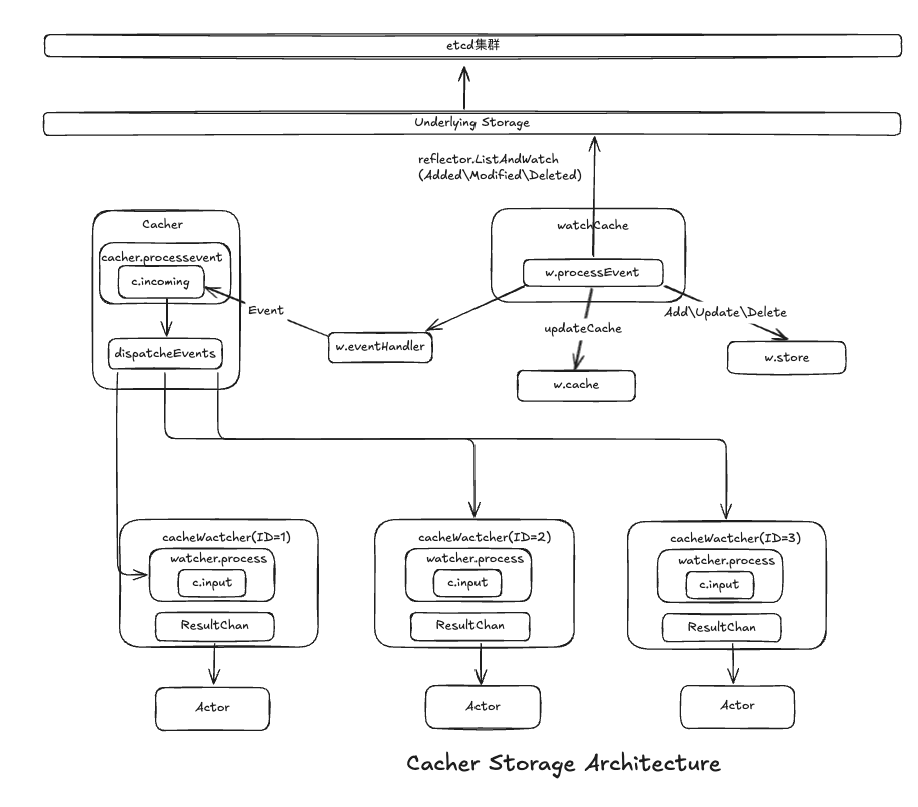
watchCache
watchCache是缓存架构基于Reflector框架的ListAndWatch func通过Underlying Storage 监听etcd集群的事件
-
func (c *Cacher) startCaching(stopChannel <-chan struct{}) {
// The 'usable' lock is always 'RLock'able when it is safe to use the cache.
// It is safe to use the cache after a successful list until a disconnection.
// We start with usable (write) locked. The below OnReplace function will
// unlock it after a successful list. The below defer will then re-lock
// it when this function exits (always due to disconnection), only if
// we actually got a successful list. This cycle will repeat as needed.
successfulList := false
c.watchCache.SetOnReplace(func() {
successfulList = true
c.ready.set(true)
klog.V(1).Infof("cacher (%v): initialized", c.objectType.String())
metrics.WatchCacheInitializations.WithLabelValues(c.objectType.String()).Inc()
})
defer func() {
if successfulList {
c.ready.set(false)
}
}()
c.terminateAllWatchers()
// Note that since onReplace may be not called due to errors, we explicitly
// need to retry it on errors under lock.
// Also note that startCaching is called in a loop, so there's no need
// to have another loop here.
if err := c.reflector.ListAndWatch(stopChannel); err != nil {
klog.Errorf("cacher (%v): unexpected ListAndWatch error: %v; reinitializing...", c.objectType.String(), err)
}
}
reflector框架提供了接收事件回调:实现了Add、Update、Delete函数
w.store:接收到事件存储到本地缓存,数据结构为cache.Indexer,功能与client-go到Indexer相同
w.cache:是一个环形缓存队列,将事件存储至缓存滑动窗口,提供对Watch 操作的缓存数据,防止因为网络或其他原因Watch连接中断,导致事件丢失
w.eventHandler:把事件分发给Cacher,Cacher进一步将事件二级分发给目前所有已建立连接Watcher,分发过程使用非阻塞式
-
// processEvent is safe as long as there is at most one call to it in flight
// at any point in time.
func (w *watchCache) processEvent(event watch.Event, resourceVersion uint64, updateFunc func(*storeElement) error) error {
key, err := w.keyFunc(event.Object)
if err != nil {
return fmt.Errorf("couldn't compute key: %v", err)
}
elem := &storeElement{Key: key, Object: event.Object}
elem.Labels, elem.Fields, err = w.getAttrsFunc(event.Object)
if err != nil {
return err
}
wcEvent := &watchCacheEvent{
Type: event.Type,
Object: elem.Object,
ObjLabels: elem.Labels,
ObjFields: elem.Fields,
Key: key,
ResourceVersion: resourceVersion,
RecordTime: w.clock.Now(),
}
if err := func() error {
// TODO: We should consider moving this lock below after the watchCacheEvent
// is created. In such situation, the only problematic scenario is Replace(
// happening after getting object from store and before acquiring a lock.
// Maybe introduce another lock for this purpose.
w.Lock()
defer w.Unlock()
previous, exists, err := w.store.Get(elem)
if err != nil {
return err
}
if exists {
previousElem := previous.(*storeElement)
wcEvent.PrevObject = previousElem.Object
wcEvent.PrevObjLabels = previousElem.Labels
wcEvent.PrevObjFields = previousElem.Fields
}
w.updateCache(wcEvent)
w.resourceVersion = resourceVersion
defer w.cond.Broadcast()
return updateFunc(elem)
}(); err != nil {
return err
}
// Avoid calling event handler under lock.
// This is safe as long as there is at most one call to Add/Update/Delete and
// UpdateResourceVersion in flight at any point in time, which is true now,
// because reflector calls them synchronously from its main thread.
if w.eventHandler != nil {
w.eventHandler(wcEvent)
}
return nil
}
Cacher
Cacher把接收到的watchCache回调发送过来的事件后,遍历目前所有已经连接的Watcher,并且把事件逐个分发给每个Watcher,分发过程使用非阻塞
-
func (c *cacheWatcher) nonblockingAdd(event *watchCacheEvent) bool {
select {
case c.input <- event:
return true
default:
return false
}
}
这里的非阻塞式是相对的,优先采用非阻塞
为了容忍短暂的连接异常,当非阻塞失败事件转发,K8s首先尝试设置一个定时器,延迟发送时间,当定时器延迟发送超时还是没有事件发送,才会关闭对应的Broker Watch连接
cacheWatcher
kube-apiserver会为每个watch请求的客户端发起一个独立的cacheWatcher实例,用于接收Watch事件
-
// Watch implements storage.Interface.
func (c *Cacher) Watch(ctx context.Context, key string, opts storage.ListOptions) (watch.Interface, error) {
...
// Create a watcher here to reduce memory allocations under lock,
// given that memory allocation may trigger GC and block the thread.
// Also note that emptyFunc is a placeholder, until we will be able
// to compute watcher.forget function (which has to happen under lock).
watcher := newCacheWatcher(chanSize, filterWithAttrsFunction(key, pred), emptyFunc, c.versioner, deadline, pred.AllowWatchBookmarks, c.objectType, identifier)
// We explicitly use thread unsafe version and do locking ourself to ensure that
// no new events will be processed in the meantime. The watchCache will be unlocked
// on return from this function.
// Note that we cannot do it under Cacher lock, to avoid a deadlock, since the
// underlying watchCache is calling processEvent under its lock.
c.watchCache.RLock()
defer c.watchCache.RUnlock()
cacheInterval, err := c.watchCache.getAllEventsSinceLocked(watchRV)
if err != nil {
// To match the uncached watch implementation, once we have passed authn/authz/admission,
// and successfully parsed a resource version, other errors must fail with a watch event of type ERROR,
// rather than a directly returned error.
return newErrWatcher(err), nil
}
func() {
c.Lock()
defer c.Unlock()
// Update watcher.forget function once we can compute it.
watcher.forget = forgetWatcher(c, watcher, c.watcherIdx, triggerValue, triggerSupported)
c.watchers.addWatcher(watcher, c.watcherIdx, triggerValue, triggerSupported)
// Add it to the queue only when the client support watch bookmarks.
if watcher.allowWatchBookmarks {
c.bookmarkWatchers.addWatcher(watcher)
}
c.watcherIdx++
}()
...
}
当客户端发起Watch请求,通过newCacheWatcher func 实例化cacheWatcher对象,并分配一个ID。这个ID全局唯一,从0开始计数,当有新的客户端发送Watch请求,ID自增1.kube-apiserver重启重置。
Cacher通过map维护cacherWatcher实例,key为ID,value为cacheWatcher
-
type watchersMap map[int]*cacheWatcher
在cacherWatcher初始化,会同时启动一个goroutine协程,最终调用watcher.process func,监听c.input.channel中的数据,当其中没有数据,会进入阻塞;其他有数据,通过ResultChan对外暴露,只发送大于ResourceVersion
-
func (c *cacheWatcher) process(ctx context.Context, resourceVersion uint64) {
// At this point we already start processing incoming watch events.
// However, the init event can still be processed because their serialization
// and sending to the client happens asynchrnously.
// TODO: As describe in the KEP, we would like to estimate that by delaying
// the initialization signal proportionally to the number of events to
// process, but we're leaving this to the tuning phase.
utilflowcontrol.WatchInitialized(ctx)
for {
select {
case event, ok := <-c.input:
if !ok {
return
}
// only send events newer than resourceVersion
if event.ResourceVersion > resourceVersion {
c.sendWatchCacheEvent(event)
}
case <-ctx.Done():
return
}
}
}
ReourceVersion资源版本号
ReourceVersion是K8s资源对象中非常重要的元素
- 用于资源更新的冲突检测
- 在List和Watch阶段防止事件丢失
- 每次对etcd中资源对象修改的时候,都会更新ResourceVersion
- Client-go根据ResourceVersion就可以标志资源对象是否变化
- 如果Watch意外端开,从上次的ResourceVersion开始重新监听,确保Watch连贯
K8s没有对ResourceVersion有额外的实现,依赖etcd的全局Indexer实例,有俩个核心的Indexer,分为createdIndex和modifiedIndex
- createdIndex:全局唯一且递增的正整数,每次在etcd集群中创建key时就会递增
- modifiedIndex:与createdIndex相视,但是每次对etcd集群中的key进行修改的时候递增
- createdIndex和modifiedIndex都通过原子操作更新
以storage.Interface Get为例:
-
// Get implements storage.Interface.Get.
func (s *store) Get(ctx context.Context, key string, opts storage.GetOptions, out runtime.Object) error {
preparedKey, err := s.prepareKey(key)
if err != nil {
return err
}
startTime := time.Now()
getResp, err := s.client.KV.Get(ctx, preparedKey)
metrics.RecordEtcdRequestLatency("get", getTypeName(out), startTime)
if err != nil {
return err
}
if err = s.validateMinimumResourceVersion(opts.ResourceVersion, uint64(getResp.Header.Revision)); err != nil {
return err
}
if len(getResp.Kvs) == 0 {
if opts.IgnoreNotFound {
return runtime.SetZeroValue(out)
}
return storage.NewKeyNotFoundError(preparedKey, 0)
}
kv := getResp.Kvs[0]
data, _, err := s.transformer.TransformFromStorage(ctx, kv.Value, authenticatedDataString(preparedKey))
if err != nil {
return storage.NewInternalError(err.Error())
}
return decode(s.codec, s.versioner, data, out, kv.ModRevision)
}
watchCache缓存滑动窗口
接收Reflector的事件回调,把事件分发到3个地方进行处理,其中之一就是缓存滑动窗口
常见缓存算法
- FIFO
- 特点:先进先出,实现简单
- 数据结构:队列
- 淘汰原则:当缓存满,移除最先进入到数据
- LRU
- 特点:按照时间维度,优先移除最久未使用
- 数据结构:链表和HashMap
- 淘汰原则:根据缓存使用时间维度,优先移除最不常用的缓存数据
- LFU
- 特点:按照统计维度,优先移除访问次数最少的数据
- 数据结构:链表和HashMap
- 淘汰原则:根据缓存数据使用次数,优先移除访问次数最少的缓存数据
watchCache实现
watchCache使用缓存滑动窗口,跟FIFO类似
-
// watchCache implements a Store interface.
// However, it depends on the elements implementing runtime.Object interface.
//
// watchCache is a "sliding window" (with a limited capacity) of objects
// observed from a watch.
type watchCache struct {
sync.RWMutex
// Condition on which lists are waiting for the fresh enough
// resource version.
cond *sync.Cond
// Maximum size of history window.
// 缓存滑动窗口大小,默认100
// 可以通过--default-watch-cache-size 参数设置
// 如果是0 禁用watchCache
capacity int
// upper bound of capacity since event cache has a dynamic size.
upperBoundCapacity int
// lower bound of capacity since event cache has a dynamic size.
lowerBoundCapacity int
// keyFunc is used to get a key in the underlying storage for a given object.
keyFunc func(runtime.Object) (string, error)
// getAttrsFunc is used to get labels and fields of an object.
getAttrsFunc func(runtime.Object) (labels.Set, fields.Set, error)
// cache is used a cyclic buffer - its first element (with the smallest
// resourceVersion) is defined by startIndex, its last element is defined
// by endIndex (if cache is full it will be startIndex + capacity).
// Both startIndex and endIndex can be greater than buffer capacity -
// you should always apply modulo capacity to get an index in cache array.
// 缓存滑动窗口,通过一个固定大小的数组形成一个环形缓冲区,可以向前滑动,当缓存滑动窗口满,移除最先进入到缓存滑动窗口的数据
cache []*watchCacheEvent
// 开始下标
startIndex int
// 结束下标
endIndex int
// store will effectively support LIST operation from the "end of cache
// history" i.e. from the moment just after the newest cached watched event.
// It is necessary to effectively allow clients to start watching at now.
// NOTE: We assume that <store> is thread-safe.
store cache.Indexer
// ResourceVersion up to which the watchCache is propagated.
resourceVersion uint64
// ResourceVersion of the last list result (populated via Replace() method).
listResourceVersion uint64
// This handler is run at the end of every successful Replace() method.
onReplace func()
// This handler is run at the end of every Add/Update/Delete method
// and additionally gets the previous value of the object.
eventHandler func(*watchCacheEvent)
// for testing timeouts.
clock clock.Clock
// An underlying storage.Versioner.
versioner storage.Versioner
// cacher's objectType.
objectType reflect.Type
// For testing cache interval invalidation.
indexValidator indexValidator
}
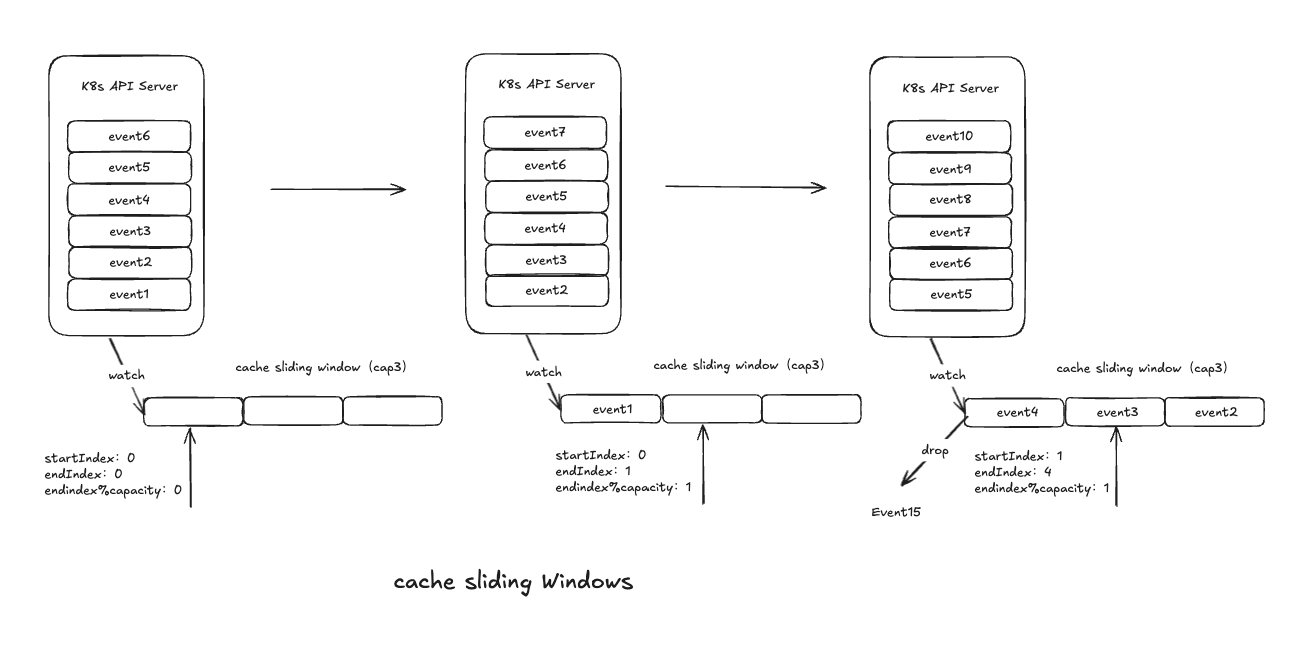
-
// Assumes that lock is already held for write.
func (w *watchCache) updateCache(event *watchCacheEvent) {
w.resizeCacheLocked(event.RecordTime)
if w.isCacheFullLocked() {
// Cache is full - remove the oldest element.
w.startIndex++
}
w.cache[w.endIndex%w.capacity] = event
w.endIndex++
}
Wacth的端点续传,确保资源不会丢失:
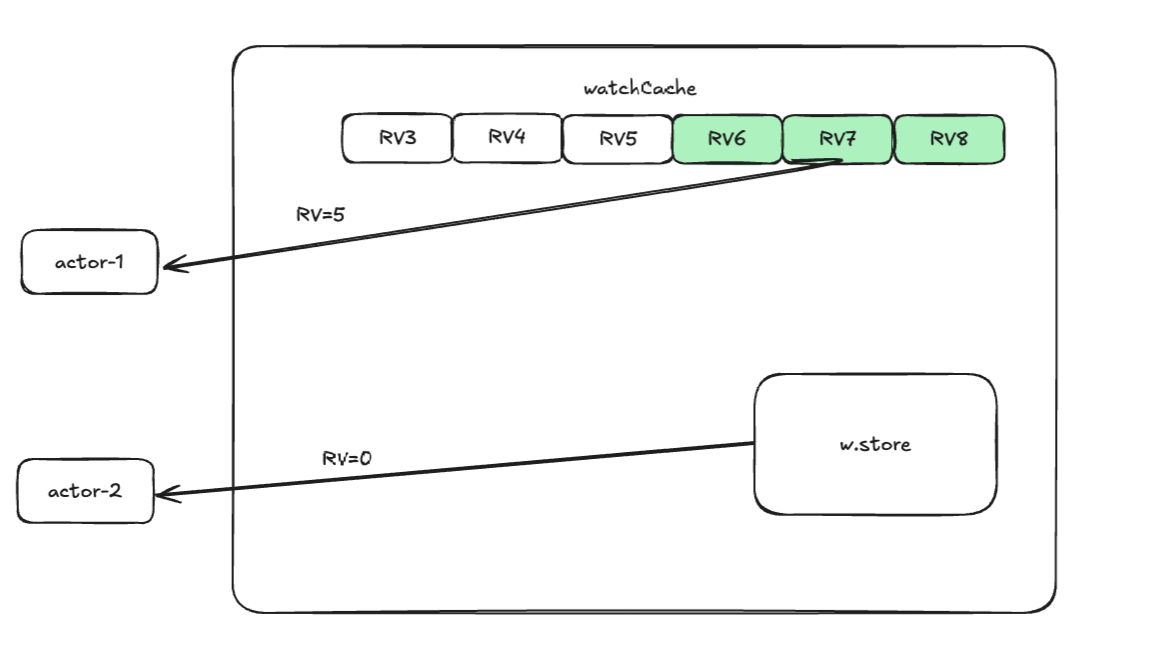
- actor1因为一些意外导致watch中断 中断前,最后一次是RV5
- 恢复时,请求Watch➕RV5
- watchCache从历史中,一次性把RV6、RV7、RV8一次性返回给actor1
- actor2使用RV0,全量获取cache历史记录
-
// getAllEventsSinceLocked returns a watchCacheInterval that can be used to
// retrieve events since a certain resourceVersion. This function assumes to
// be called under the watchCache lock.
func (w *watchCache) getAllEventsSinceLocked(resourceVersion uint64) (*watchCacheInterval, error) {
size := w.endIndex - w.startIndex
var oldest uint64
switch {
case w.listResourceVersion > 0 && w.startIndex == 0:
// If no event was removed from the buffer since last relist, the oldest watch
// event we can deliver is one greater than the resource version of the list.
oldest = w.listResourceVersion + 1
case size > 0:
// If the previous condition is not satisfied: either some event was already
// removed from the buffer or we've never completed a list (the latter can
// only happen in unit tests that populate the buffer without performing
// list/replace operations), the oldest watch event we can deliver is the first
// one in the buffer.
oldest = w.cache[w.startIndex%w.capacity].ResourceVersion
default:
return nil, fmt.Errorf("watch cache isn't correctly initialized")
}
if resourceVersion == 0 {
// resourceVersion = 0 means that we don't require any specific starting point
// and we would like to start watching from ~now.
// However, to keep backward compatibility, we additionally need to return the
// current state and only then start watching from that point.
//
// TODO: In v2 api, we should stop returning the current state - #13969.
ci, err := newCacheIntervalFromStore(w.resourceVersion, w.store, w.getAttrsFunc)
if err != nil {
return nil, err
}
return ci, nil
}
if resourceVersion < oldest-1 {
return nil, errors.NewResourceExpired(fmt.Sprintf("too old resource version: %d (%d)", resourceVersion, oldest-1))
}
// Binary search the smallest index at which resourceVersion is greater than the given one.
f := func(i int) bool {
return w.cache[(w.startIndex+i)%w.capacity].ResourceVersion > resourceVersion
}
first := sort.Search(size, f)
indexerFunc := func(i int) *watchCacheEvent {
return w.cache[i%w.capacity]
}
ci := newCacheInterval(w.startIndex+first, w.endIndex, indexerFunc, w.indexValidator, &w.RWMutex)
return ci, nil
}
Underlying Storage底层存储对象
Underlying Storage是后端存储,真正和etcd交互的资源对象
-
// Create creates a storage backend based on given config.
func Create(c storagebackend.ConfigForResource, newFunc func() runtime.Object) (storage.Interface, DestroyFunc, error) {
switch c.Type {
case storagebackend.StorageTypeETCD2:
return nil, nil, fmt.Errorf("%s is no longer a supported storage backend", c.Type)
case storagebackend.StorageTypeUnset, storagebackend.StorageTypeETCD3:
return newETCD3Storage(c, newFunc)
default:
return nil, nil, fmt.Errorf("unknown storage type: %s", c.Type)
}
} 在默认情况下,资源对象(除了CustomReource)之外,在etcd中都使用二进制(application/vnd.kubernetes.protobbuf)编码存储
- 除了默认提供的Protobuf编码格式,还支持
application/json和application/yaml编码格式
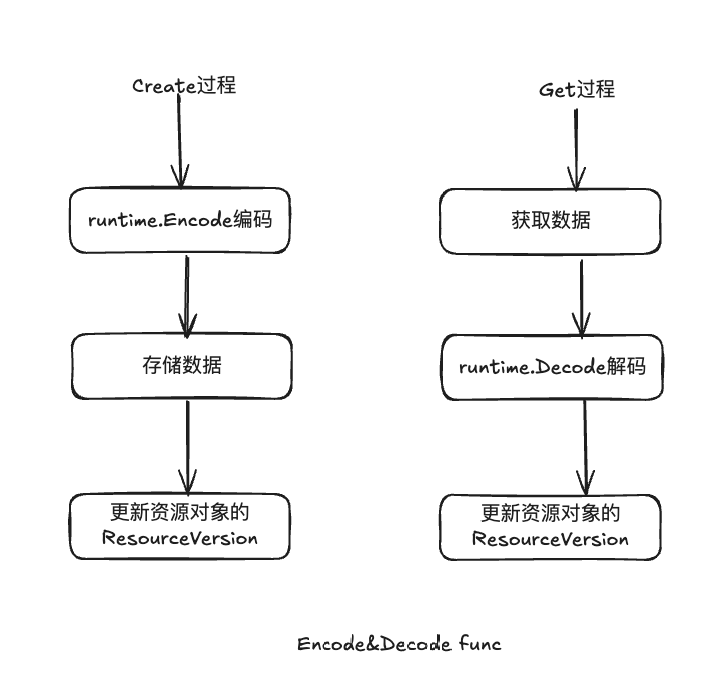
- 除了默认提供的Protobuf编码格式,还支持
-
// Get implements storage.Interface.Get.
func (s *store) Get(ctx context.Context, key string, opts storage.GetOptions, out runtime.Object) error {
preparedKey, err := s.prepareKey(key)
if err != nil {
return err
}
startTime := time.Now()
getResp, err := s.client.KV.Get(ctx, preparedKey)
metrics.RecordEtcdRequestLatency("get", getTypeName(out), startTime)
if err != nil {
return err
}
if err = s.validateMinimumResourceVersion(opts.ResourceVersion, uint64(getResp.Header.Revision)); err != nil {
return err
}
if len(getResp.Kvs) == 0 {
if opts.IgnoreNotFound {
return runtime.SetZeroValue(out)
}
return storage.NewKeyNotFoundError(preparedKey, 0)
}
kv := getResp.Kvs[0]
data, _, err := s.transformer.TransformFromStorage(ctx, kv.Value, authenticatedDataString(preparedKey))
if err != nil {
return storage.NewInternalError(err.Error())
}
return decode(s.codec, s.versioner, data, out, kv.ModRevision)
}
流程:
- 通过s.client.KV.Get func获取etcd集群中的资源对象的存储数据
- 通过protobufSerializer 编码器(code.Decode func)将二进制数据进行解码,将解码的数据存放到objptr中
- 通过version.UpdateObject func更新(填充资源对象)
K8s默认基于gRPC和etcd集群交互
Codec数据编码/解码
- 实例化Scheme资源
- 通过clientv3.New实例化etcd v3 client对象
- 通过newCode func实例化runtime.Codec
- 通过runtime.Decode解码器将资源对象解码为资源对象
- 通过runtime.Encode 转换为JSON打印
Strategy预处理
在K8s中,每种资源都有自己的预处理操作,它在资源对象的创建、更新、删除之前,实现资源持久化存储前的预处理。
一般都定义在
pkg/registry/<资源组>/<资源>/straregy.go中-
// GenericStore interface can be used for type assertions when we need to access the underlying strategies.
type GenericStore interface {
// 返回创建资源的预操作
GetCreateStrategy() rest.RESTCreateStrategy
// 返回资源更新的预操作
GetUpdateStrategy() rest.RESTUpdateStrategy
// 返回资源删除的预操作
GetDeleteStrategy() rest.RESTDeleteStrategy
}
Create Strategy预处理
-
// RESTCreateStrategy defines the minimum validation, accepted input, and
// name generation behavior to create an object that follows Kubernetes
// API conventions.
type RESTCreateStrategy interface {
// 获取和检查资源对象的APIVersion和Kind信息
runtime.ObjectTyper
// The name generator is used when the standard GenerateName field is set.
// The NameGenerator will be invoked prior to validation.
// 支持GenerateName,根据前缀自动生成名字
names.NameGenerator
// NamespaceScoped returns true if the object must be within a namespace.
// 判断当前资源是否在命名空间范围内
NamespaceScoped() bool
// PrepareForCreate is invoked on create before validation to normalize
// the object. For example: remove fields that are not to be persisted,
// sort order-insensitive list fields, etc. This should not remove fields
// whose presence would be considered a validation error.
//
// Often implemented as a type check and an initailization or clearing of
// status. Clear the status because status changes are internal. External
// callers of an api (users) should not be setting an initial status on
// newly created objects.
// 定义创建资源对象前的操作
PrepareForCreate(ctx context.Context, obj runtime.Object)
// Validate returns an ErrorList with validation errors or nil. Validate
// is invoked after default fields in the object have been filled in
// before the object is persisted. This method should not mutate the
// object.
// 验证对象是否合法
Validate(ctx context.Context, obj runtime.Object) field.ErrorList
// WarningsOnCreate returns warnings to the client performing a create.
// WarningsOnCreate is invoked after default fields in the object have been filled in
// and after Validate has passed, before Canonicalize is called, and the object is persisted.
// This method must not mutate the object.
//
// Be brief; limit warnings to 120 characters if possible.
// Don't include a "Warning:" prefix in the message (that is added by clients on output).
// Warnings returned about a specific field should be formatted as "path.to.field: message".
// For example: `spec.imagePullSecrets[0].name: invalid empty name ""`
//
// Use warning messages to describe problems the client making the API request should correct or be aware of.
// For example:
// - use of deprecated fields/labels/annotations that will stop working in a future release
// - use of obsolete fields/labels/annotations that are non-functional
// - malformed or invalid specifications that prevent successful handling of the submitted object,
// but are not rejected by validation for compatibility reasons
//
// Warnings should not be returned for fields which cannot be resolved by the caller.
// For example, do not warn about spec fields in a subresource creation request.
// 定义在创建资源对象的警告信息
WarningsOnCreate(ctx context.Context, obj runtime.Object) []string
// Canonicalize allows an object to be mutated into a canonical form. This
// ensures that code that operates on these objects can rely on the common
// form for things like comparison. Canonicalize is invoked after
// validation has succeeded but before the object has been persisted.
// This method may mutate the object. Often implemented as a type check or
// empty method.
// 在创建资源前,进行规范化处理,确保存储的数据格式是否通用
Canonicalize(obj runtime.Object)
}
Update Strategy预处理
-
// RESTUpdateStrategy defines the minimum validation, accepted input, and
// name generation behavior to update an object that follows Kubernetes
// API conventions. A resource may have many UpdateStrategies, depending on
// the call pattern in use.
type RESTUpdateStrategy interface {
runtime.ObjectTyper
// NamespaceScoped returns true if the object must be within a namespace.
NamespaceScoped() bool
// AllowCreateOnUpdate returns true if the object can be created by a PUT.
// 判断当前资源是否在命名空间范围内
AllowCreateOnUpdate() bool
// PrepareForUpdate is invoked on update before validation to normalize
// the object. For example: remove fields that are not to be persisted,
// sort order-insensitive list fields, etc. This should not remove fields
// whose presence would be considered a validation error.
PrepareForUpdate(ctx context.Context, obj, old runtime.Object)
// ValidateUpdate is invoked after default fields in the object have been
// filled in before the object is persisted. This method should not mutate
// the object.
ValidateUpdate(ctx context.Context, obj, old runtime.Object) field.ErrorList
// WarningsOnUpdate returns warnings to the client performing the update.
// WarningsOnUpdate is invoked after default fields in the object have been filled in
// and after ValidateUpdate has passed, before Canonicalize is called, and before the object is persisted.
// This method must not mutate either object.
//
// Be brief; limit warnings to 120 characters if possible.
// Don't include a "Warning:" prefix in the message (that is added by clients on output).
// Warnings returned about a specific field should be formatted as "path.to.field: message".
// For example: `spec.imagePullSecrets[0].name: invalid empty name ""`
//
// Use warning messages to describe problems the client making the API request should correct or be aware of.
// For example:
// - use of deprecated fields/labels/annotations that will stop working in a future release
// - use of obsolete fields/labels/annotations that are non-functional
// - malformed or invalid specifications that prevent successful handling of the submitted object,
// but are not rejected by validation for compatibility reasons
//
// Warnings should not be returned for fields which cannot be resolved by the caller.
// For example, do not warn about spec fields in a status update.
WarningsOnUpdate(ctx context.Context, obj, old runtime.Object) []string
// Canonicalize allows an object to be mutated into a canonical form. This
// ensures that code that operates on these objects can rely on the common
// form for things like comparison. Canonicalize is invoked after
// validation has succeeded but before the object has been persisted.
// This method may mutate the object.
Canonicalize(obj runtime.Object)
// AllowUnconditionalUpdate returns true if the object can be updated
// unconditionally (irrespective of the latest resource version), when
// there is no resource version specified in the object.
AllowUnconditionalUpdate() bool
}
Delete Strategy预处理
-
// BeforeDelete tests whether the object can be gracefully deleted.
// If graceful is set, the object should be gracefully deleted. If gracefulPending
// is set, the object has already been gracefully deleted (and the provided grace
// period is longer than the time to deletion). An error is returned if the
// condition cannot be checked or the gracePeriodSeconds is invalid. The options
// argument may be updated with default values if graceful is true. Second place
// where we set deletionTimestamp is pkg/registry/generic/registry/store.go.
// This function is responsible for setting deletionTimestamp during gracefulDeletion,
// other one for cascading deletions.
func BeforeDelete(strategy RESTDeleteStrategy, ctx context.Context, obj runtime.Object, options *metav1.DeleteOptions) (graceful, gracefulPending bool, err error) {
objectMeta, gvk, kerr := objectMetaAndKind(strategy, obj)
if kerr != nil {
return false, false, kerr
}
if errs := validation.ValidateDeleteOptions(options); len(errs) > 0 {
return false, false, errors.NewInvalid(schema.GroupKind{Group: metav1.GroupName, Kind: "DeleteOptions"}, "", errs)
}
// Checking the Preconditions here to fail early. They'll be enforced later on when we actually do the deletion, too.
if options.Preconditions != nil {
if options.Preconditions.UID != nil && *options.Preconditions.UID != objectMeta.GetUID() {
return false, false, errors.NewConflict(schema.GroupResource{Group: gvk.Group, Resource: gvk.Kind}, objectMeta.GetName(), fmt.Errorf("the UID in the precondition (%s) does not match the UID in record (%s). The object might have been deleted and then recreated", *options.Preconditions.UID, objectMeta.GetUID()))
}
if options.Preconditions.ResourceVersion != nil && *options.Preconditions.ResourceVersion != objectMeta.GetResourceVersion() {
return false, false, errors.NewConflict(schema.GroupResource{Group: gvk.Group, Resource: gvk.Kind}, objectMeta.GetName(), fmt.Errorf("the ResourceVersion in the precondition (%s) does not match the ResourceVersion in record (%s). The object might have been modified", *options.Preconditions.ResourceVersion, objectMeta.GetResourceVersion()))
}
}
// Negative values will be treated as the value `1s` on the delete path.
if gracePeriodSeconds := options.GracePeriodSeconds; gracePeriodSeconds != nil && *gracePeriodSeconds < 0 {
options.GracePeriodSeconds = utilpointer.Int64(1)
}
if deletionGracePeriodSeconds := objectMeta.GetDeletionGracePeriodSeconds(); deletionGracePeriodSeconds != nil && *deletionGracePeriodSeconds < 0 {
objectMeta.SetDeletionGracePeriodSeconds(utilpointer.Int64(1))
}
gracefulStrategy, ok := strategy.(RESTGracefulDeleteStrategy)
if !ok {
// If we're not deleting gracefully there's no point in updating Generation, as we won't update
// the obcject before deleting it.
return false, false, nil
}
// if the object is already being deleted, no need to update generation.
if objectMeta.GetDeletionTimestamp() != nil {
// if we are already being deleted, we may only shorten the deletion grace period
// this means the object was gracefully deleted previously but deletionGracePeriodSeconds was not set,
// so we force deletion immediately
// IMPORTANT:
// The deletion operation happens in two phases.
// 1. Update to set DeletionGracePeriodSeconds and DeletionTimestamp
// 2. Delete the object from storage.
// If the update succeeds, but the delete fails (network error, internal storage error, etc.),
// a resource was previously left in a state that was non-recoverable. We
// check if the existing stored resource has a grace period as 0 and if so
// attempt to delete immediately in order to recover from this scenario.
if objectMeta.GetDeletionGracePeriodSeconds() == nil || *objectMeta.GetDeletionGracePeriodSeconds() == 0 {
return false, false, nil
}
// only a shorter grace period may be provided by a user
if options.GracePeriodSeconds != nil {
period := int64(*options.GracePeriodSeconds)
if period >= *objectMeta.GetDeletionGracePeriodSeconds() {
return false, true, nil
}
newDeletionTimestamp := metav1.NewTime(
objectMeta.GetDeletionTimestamp().Add(-time.Second * time.Duration(*objectMeta.GetDeletionGracePeriodSeconds())).
Add(time.Second * time.Duration(*options.GracePeriodSeconds)))
objectMeta.SetDeletionTimestamp(&newDeletionTimestamp)
objectMeta.SetDeletionGracePeriodSeconds(&period)
return true, false, nil
}
// graceful deletion is pending, do nothing
options.GracePeriodSeconds = objectMeta.GetDeletionGracePeriodSeconds()
return false, true, nil
}
// `CheckGracefulDelete` will be implemented by specific strategy
if !gracefulStrategy.CheckGracefulDelete(ctx, obj, options) {
return false, false, nil
}
if options.GracePeriodSeconds == nil {
return false, false, errors.NewInternalError(fmt.Errorf("options.GracePeriodSeconds should not be nil"))
}
now := metav1.NewTime(metav1.Now().Add(time.Second * time.Duration(*options.GracePeriodSeconds)))
objectMeta.SetDeletionTimestamp(&now)
objectMeta.SetDeletionGracePeriodSeconds(options.GracePeriodSeconds)
// If it's the first graceful deletion we are going to set the DeletionTimestamp to non-nil.
// Controllers of the object that's being deleted shouldn't take any nontrivial actions, hence its behavior changes.
// Thus we need to bump object's Generation (if set). This handles generation bump during graceful deletion.
// The bump for objects that don't support graceful deletion is handled in pkg/registry/generic/registry/store.go.
if objectMeta.GetGeneration() > 0 {
objectMeta.SetGeneration(objectMeta.GetGeneration() + 1)
}
return true, false, nil
}

